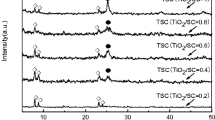Abstract
Fe2O3-SiO2 composites were prepared by impregnation (sample FeIMP) or doping (sample FeDOP) in the structure of porous silica. The dye removal capacity of the materials was investigated through adsorption and oxidation studies of methylene blue and rhodamine B. N2 adsorption/desorption measurements on FeIMP and FeDOP resulted in specific areas of 27 and 235 m2 g−1, respectively. Mössbauer spectroscopy and XRD data detected hematite and maghemite as the iron phases in the samples FeIMP and FeDOP, respectively. Adsorption isotherms and kinetic studies of the dyes were better fitted in DKR model for FeDOP, where the process follows a pseudo-second order with the interparticle diffusion step being the rate-limiting step. On the other hand, FeIMP has better fit in the Langmuir model. Photocatalytic activity was observed in FeDOP under UV irradiation by the presence of reaction-hydroxylated intermediates for MB (m/z = 301) and RhB (m/z = 459). However, the photocatalytic activity was strongly influenced by the adsorption affinity between dye/catalyst. Photogenerated holes are the species responsible for the dye degradation when the adsorption is too strong, while hydroxyl radical action will be favored when the adsorption is not vigorous as detected by ESI-MS.

Action of photogenerated holes and free electrons into the photocatalytically mechanism of methylene blue degradation over a semiconductor














Similar content being viewed by others
References
Ajmal A, Majeed I, Malik N (2014) Principles and mechanisms of photocatalytic dye degradation on TiO2 based photocatalysts: a comparative overview. R Soc Chem Adv 4:37003–37026. doi:10.1039/c4ra06658h
Al-anber ZA, Al-anber MAS (2008) Thermodynamics and kinetic studies of iron (III) adsorption by olive cake in a batch system. J Mex Chem Soc 52:108–115
Alihosseini A, Taghikhani V, Safekordi AA, Bastani D (2010) Equilibrium sorption of crude oil by expanded perlite using different adsorption isotherms at 298. 15 k. Int J Environ Sci Technol 7:591–598
Bjørgen M, Joensen F, Spangsberg M, et al (2008) Applied Catalysis A : General Methanol to gasoline over zeolite H-ZSM-5 : Improved catalyst performance by treatment with NaOH. 345:43–50. doi: 10.1016/j.apcata.2008.04.020
Castro CS, Guerreiro MC, Gonçalves M et al (2009) Activated carbon/iron oxide composites for the removal of atrazine from aqueous medium. J Hazard Mater 164:609–614. doi:10.1016/j.jhazmat.2008.08.066
Cortes J, Araya P (1986) The Dubinin-Radushkevich-Kaganer equation. J Chem Soc Faraday Trans 82:2473–2479
de Souza WF, Guimarães IR, Guerreiro MC, Oliveira LCA (2009) Catalytic oxidation of sulfur and nitrogen compounds from diesel fuel. Appl Catal A Gen 360:205–209. doi:10.1016/j.apcata.2009.03.023
Foo KY, Hameed BH (2010) Insights into the modeling of adsorption isotherm systems. Chem Eng J 156:2–10. doi:10.1016/j.cej.2009.09.013
Gonçalves M, Guerreiro MC, de Oliveira LCA, de Castro CS (2013) A friendly environmental material: iron oxide dispersed over activated carbon from coffee husk for organic pollutants removal. J Environ Manage 127:206–11. doi:10.1016/j.jenvman.2013.05.017
Gong J-L, Wang B, Zeng G-M et al (2009) Removal of cationic dyes from aqueous solution using magnetic multi-wall carbon nanotube nanocomposite as adsorbent. J Hazard Mater 164:1517–22. doi:10.1016/j.jhazmat.2008.09.072
Hasanbeigi A, Price L (2015) A technical review of emerging technologies for energy and water efficiency and pollution reduction in the textile industry. J Clean Prod 95:30–44. doi:10.1016/j.jclepro.2015.02.079
Kordouli E, Bourikas K, Lycourghiotis A, Kordulis C (2015) The mechanism of azo-dyes adsorption on the titanium dioxide surface and their photocatalytic degradation over samples with various anatase/rutile ratios. Catal Today 252:128–135. doi:10.1016/j.cattod.2014.09.010
Litter M (1999) Heterogeneous photocatalysis transition metal ions in photocatalytic systems. Appl Catal B Environ 23:89–114. doi:10.1016/S0926-3373(99)00069-7
Marcelino RBP, Queiroz MTA, Amorim CC, et al (2014) Solar energy for wastewater treatment: review of international technologies and their applicability in Brazil. Environ Sci Pollut Res 762–773. doi: 10.1007/s11356-014-3033-2
Ohtani B (2010) Photocatalysis A to Z—what we know and what we do not know in a scientific sense. J Photochem Photobiol C Photochem Rev 11:157–178. doi:10.1016/j.jphotochemrev.2011.02.001
Oliveira LCA, Gonçalves M, Guerreiro MC et al (2007) A new catalyst material based on niobia/iron oxide composite on the oxidation of organic contaminants in water via heterogeneous Fenton mechanisms. Appl Catal A Gen 316:117–124. doi:10.1016/j.apcata.2006.09.027
Pinto ISX, Pacheco PHVV, Coelho JV et al (2012) Nanostructured δ-FeOOH: an efficient Fenton-like catalyst for the oxidation of organics in water. Appl Catal B Environ 119–120:175–182. doi:10.1016/j.apcatb.2012.02.026
Schwertmann U, Cornell RM (1991) Iron oxides in the laboratory. VCH, Nova York
Schwertmann U, Cornell RM (2003) The iron oxides: structure, properties, reactions, occurences and uses, second edition. Wiley-VCH, Weinheim
Silva AC, Oliveira DQL, Oliveira LCA et al (2009) Nb-containing hematites Fe2−xNbxO3: the role of Nb5+ on the reactivity in presence of the H2O2 or ultraviolet light. Appl Catal A Gen 357:79–84. doi:10.1016/j.apcata.2009.01.014
Srivastava SK, Tyagi R, Pant N (1989) Adsorption of heavy metal ions on carbonaceous material developed from the waste slurry generated in local fertilizer plants. Water Res 23:1161–1165
Sun Q, Yang L (2003) The adsorption of basic dyes from aqueous solution on modified peat-resin particle. Water Res 37:1535–44. doi:10.1016/S0043-1354(02)00520-1
United Nations Department of Economic and Social Affairs (2015) World Population Prospects: The 2015 Revision (ESA/P/WP.241). 1–59. doi: Working Paper No. ESA/P/WP.241
Weber WJ, Morris JC (1963) Kinetics of adsorption on carbon from solution. J Sanit Eng Div 89:31–59
Wu F-C, Tseng R-L, Juang R-S (2009) Initial behavior of intraparticle diffusion model used in the description of adsorption kinetics. Chem Eng J 153:1–8. doi:10.1016/j.cej.2009.04.042
Wu W, Jiang C, Roy VAL (2015) Recent progress in magnetic iron oxide semiconductor composite nanomaterials as promising photocatalysts. Nanoscale 7:38–58. doi:10.1039/C4NR04244A
Acknowledgments
The authors would like to thank the Brazilian National Counsel of Technological and Scientific Development (CNPq) for the funds and to the Nuclear Technology Development Center (CDTN) for the Mössbauer analysis.
Author information
Authors and Affiliations
Corresponding author
Additional information
Responsible editor: Santiago V. Luis
Rights and permissions
About this article
Cite this article
Freitas, V.A.A., Maia, L.A., Belardinelli, R.E. et al. Magnetic iron species highly dispersed over silica: use as catalysts for removal of pollutants in water. Environ Sci Pollut Res 24, 6114–6125 (2017). https://doi.org/10.1007/s11356-016-6495-6
Received:
Accepted:
Published:
Issue Date:
DOI: https://doi.org/10.1007/s11356-016-6495-6




